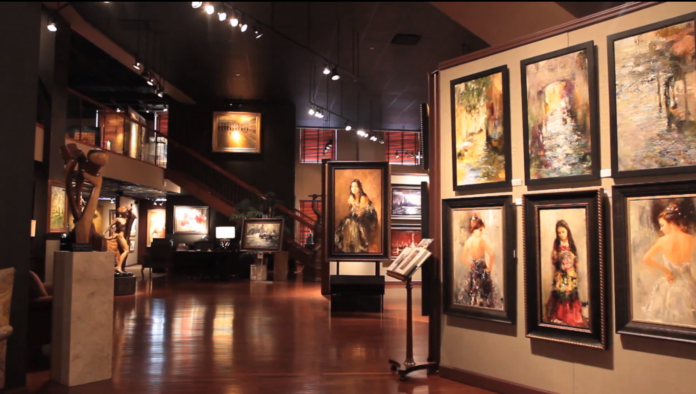If you’re considering approaching an art gallery to represent you and your work, check out these tips.
This article is sponsored by our sister site, ArtMarketing.com, and the Art Marketing Minute Podcast with Eric Rhoads.
Are You Gallery Ready?
By Henry Young
You have prepared for this day and have 25-50 works of art to sell. You have a distinct style and all your friends and family LOVE your art.
Perhaps you’ve even sold one or two pieces! Well, I hate to break it to you, but you need more than 50 works of art to sell before approaching a gallery. Say you are a talented artist with a unique style, with themes that are highly sought after, a solid oil-on-canvas technique, and a unique color scheme. You may even be famous in another field—athlete, singer, dancer, tennis player, or golfer. Your name is magic already. Do you still need more than 50 works of art before approaching a gallery? YES, you do.
Why? Well, if you do sign with a gallery and they present a show for your art, what if they sell out in two days? How long does it take you to produce a single work of art? How soon will you have another 50 works for sale? If there is a long delay between the time the art sells out at your initial show and the time you are able to amass a large body of work to replenish your stock, the public may lose interest, and your career as a successful artist will come to an abrupt halt.
What is a safe amount of art to produce for the first show at a gallery? I suggest having available 175 to 200 completed pieces. You must figure out a schedule for replenishing your art inventory so there will not be a break in production and art available for sale.
As an initial goal, emerging artists should work on having their artwork placed in a gallery. At first, just consign as many pieces as the gallery has space for you to show. If and when the reception of your works is positive, then you may ask the art gallery owner to schedule a show for you. You may have to be part of a group show at first, but this is a good start. If you are well received, you will eventually have a solo exhibition and sale. It is a good idea to get your artwork shown in a gallery at whatever level of development you happen to be at the time. A listing of galleries showing your art will only enhance your biography and chronology, as well as expose you to the public, allowing you to further test the waters with your art.
How Do You Keep Track of Your Art?
Do you have an inventory system for recordkeeping? An inventory sheet for each work of art should include:
- Your name
- Title of your artwork
- Medium
- Date
- Size (unframed and framed)
- Where and how you have signed your art
- What is on the back of the canvas? I.E. your rubberstamp logo, your signature, the medium used, and the date of the artwork.
- A very high-definition photograph of the artwork. Perhaps a transparency or digital copy (15 megapixels minimum for best quality reproduction). This is also in preparation for having your well-illustrated artist’s book published.
For visual authenticity, I suggest taking a photograph with you holding each artwork you complete. As a way to further prove the authenticity of your work in the future, you may want to consider putting three pinholes where you sign the front of the artwork. An appraiser or expert can determine if it is indeed your art by asking a collector to hold your art up to a light source and look where you signed it. The three pinholes will prove that it is indeed your artwork.
Some artists place their fingerprint on the back of the canvas or rubberstamp their special logo. On the back, they may also sign, date, and explain what media was utilized. A note on the back about a special event that happened on the day or the time when your artwork was executed also helps prove authenticity. You may even go high-tech and embed laser images—the options for proving authenticity are limitless.
Finding the Right Art Gallery
One of the most important elements when choosing a gallery is location, location, location. Years of service and success, a clear past, and a gallery owner with whom you can work are all equally important. You may have to show your portfolio to a number of galleries to start. Take good notes with each interview. You may learn something. I suggest having two or more actual paintings and the rest as images on a laptop.
Do you have marketing skills?
Consider hiring an agent if you lack the skills for marketing your own artwork. A veteran and professional agent may already have a network of galleries that he or she is currently dealing with. The right agent could place you in a number of locations across the country for immediate exposure and sales.
Do you have a published catalog or coffee table book? A catalog or coffee table book is a great tool to have when marketing your artwork. A book for a collector to thumb through provides instant credibility and is a way of showing that you are a well-established artist.
What else do you need today? You need a concise, compelling, and attention-getting story. You need a video about you, your body of work, an explanation of your story, and an introduction to you.
I am sure you have thought of all these things, but these days you must be completely prepared and educated and have a clear plan to proceed with your selection of a gallery and perhaps an agent.
I wish you all the best: a wonderful art career, a bright future, and much success.
- Visit PaintTube.tv to learn how to paint portraits and figures in the style of contemporary realism, and much more.
- Join us for the next annual Realism Live virtual art conference and study with the world’s best realism artists.
- Become a Realism Today Ambassador for the chance to see your work featured in our newsletter, on our social media, and on this site.






Excellent article. Very specific. I like that he recommends what to bring to a gallery: 2 sample paintings and the rest on a laptop.
But I wonder if putting the date on a work is absolutely necessary. I know one gallery owner who recommends against it because he says the customer often wonders why it didn’t sell earlier.
Sandra
Thank you for this article. Would there be some credentials available to list so that we can understand the author’s connection with galleries and art? Thank you!
Comments are closed.